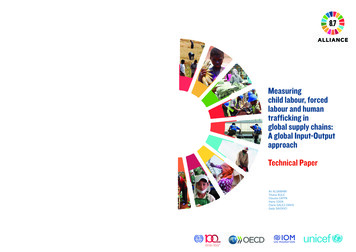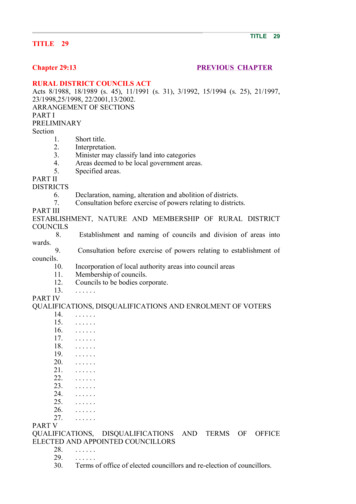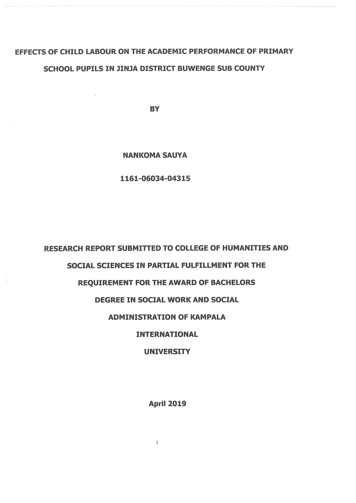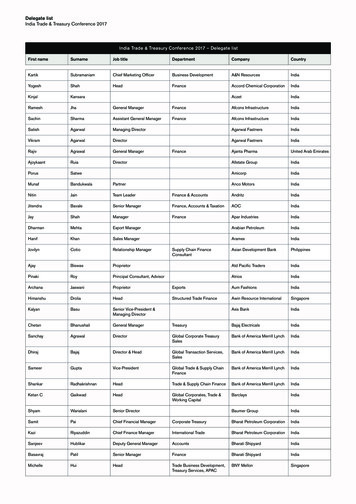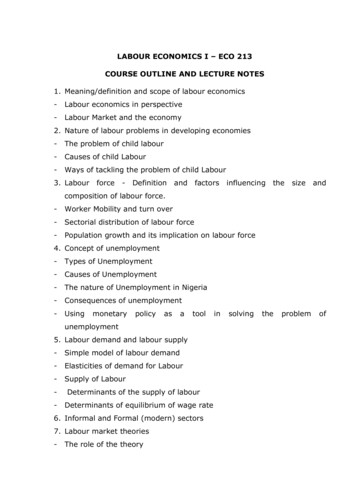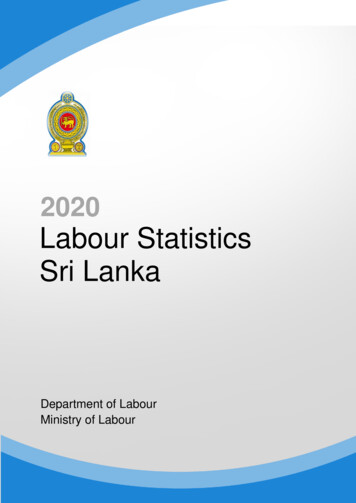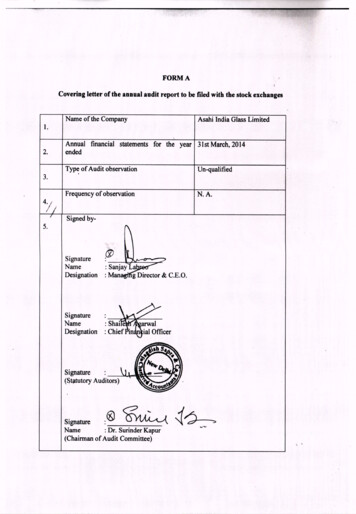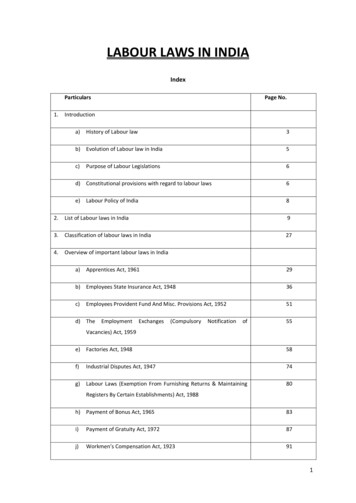
Transcription
LABOUR LAWS IN INDIAIndexParticulars1.Page No.Introductiona)History of Labour law3b) Evolution of Labour law in India5c)6Purpose of Labour Legislationsd) Constitutional provisions with regard to labour laws6e)8Labour Policy of India2.List of Labour laws in India93.Classification of labour laws in India274.Overview of important labour laws in Indiaa)Apprentices Act, 196129b) Employees State Insurance Act, 194836c)51Employees Provident Fund And Misc. Provisions Act, 1952d) acancies) Act, 1959e)Factories Act, 194858f)Industrial Disputes Act, 194774g)Labour Laws (Exemption From Furnishing Returns & Maintaining80Registers By Certain Establishments) Act, 1988h) Payment of Bonus Act, 196583i)Payment of Gratuity Act, 197287j)Workmen’s Compensation Act, 1923911
k)The Trade Unions Act, 192697l)Shops and Establishment Act, 1954101m) Laws related to wages104n) Laws related to child labour118o) Law related to contract labour129p) Maternity Benefit Act, 19611325.Checklist of labour law compliance1356.Unfair labour practice1447.Labour laws in the unorganized sector1478.Women labour and the Law1519.Industrial relations15710. Special points to be noted while drafting Employment Agreement17211. Important case laws under various labour legislations17712. Important organizations17913. Authorities under the labour law in India18014. Labour legislations across the world18615. Bibliography19016. Annexurea)Agreements between employee and employer192b) Agreement for reference of disputes to arbitration1962
1. INTRODUCTIONLabour law also known as employment law is the body of laws, administrative rulings, andprecedents which address the legal rights of, and restrictions on, working people and theirorganizations. As such, it mediates many aspects of the relationship between trade unions,employers and employees. In other words, Labour law defines the rights and obligations as workers,union members and employers in the workplace. Generally, labour law covers: Industrial relations – certification of unions, labour-management relations, collectivebargaining and unfair labour practices; Workplace health and safety; Employment standards, including general holidays, annual leave, working hours, unfairdismissals, minimum wage, layoff procedures and severance pay.There are two broad categories of labour law. First, collective labour law relates to the tripartiterelationship between employee, employer and union. Second, individual labour law concernsemployees' rights at work and through the contract for work.The labour movement has been instrumental in the enacting of laws protecting labour rights in the19th and 20th centuries. Labour rights have been integral to the social and economic developmentsince the industrial revolution.1.1. History of Labour lawsLabour law arose due to the demands of workers for better conditions, the right to organize, and thesimultaneous demands of employers to restrict the powers of workers in many organizations and tokeep labour costs low. Employers' costs can increase due to workers organizing to win higher wages,or by laws imposing costly requirements, such as health and safety or equal opportunitiesconditions. Workers' organizations, such as trade unions, can also transcend purely industrialdisputes, and gain political power - which some employers may oppose. The state of labour law atany one time is therefore both the product of, and a component of, struggles between differentinterests in society.International Labour Organisation (ILO) was one of the first organisations to deal with labour issues.The ILO was established as an agency of the League of Nations following the Treaty of Versailles,which ended World War I. Post-war reconstruction and the protection of labour unions occupied theattention of many nations during and immediately after World War I. In Great Britain, the Whitley3
Commission, a subcommittee of the Reconstruction Commission, recommended in its July 1918 FinalReport that "industrial councils" be established throughout the world. The British Labour Party hadissued its own reconstruction programme in the document titled Labour and the New Social Order.In February 1918, the third Inter-Allied Labour and Socialist Conference (representing delegates fromGreat Britain, France, Belgium and Italy) issued its report, advocating an international labour rightsbody, an end to secret diplomacy, and other goals. And in December 1918, the American Federationof Labor (AFL) issued its own distinctively apolitical report, which called for the achievement ofnumerous incremental improvements via the collective bargaining process.As the war drew to a close, two competing visions for the post-war world emerged. The first wasoffered by the International Federation of Trade Unions (IFTU), which called for a meeting in Bernein July 1919. The Berne meeting would consider both the future of the IFTU and the variousproposals which had been made in the previous few years. The IFTU also proposed includingdelegates from the Central Powers as equals. Samuel Gompers, president of the AFL, boycotted themeeting, wanting the Central Powers delegates in a subservient role as an admission of guilt for theircountries' role in the bringing about war. Instead, Gompers favored a meeting in Paris which wouldonly consider President Woodrow Wilson's Fourteen Points as a platform. Despite the Americanboycott, the Berne meeting went ahead as scheduled. In its final report, the Berne Conferencedemanded an end to wage labour and the establishment of socialism. If these ends could not beimmediately achieved, then an international body attached to the League of Nations should enactand enforce legislation to protect workers and trade unions.The British proposed establishing an international parliament to enact labour laws which eachmember of the League would be required to implement. Each nation would have two delegates tothe parliament, one each from labour and management. An international labour office would collectstatistics on labour issues and enforce the new international laws. Philosophically opposed to theconcept of an international parliament and convinced that international standards would lower thefew protections achieved in the United States, Gompers proposed that the international labour bodybe authorized only to make recommendations, and that enforcement be left up to the League ofNations. Despite vigorous opposition from the British, the American proposal was adopted.The Americans made 10 proposals. Three were adopted without change: That labour should not betreated as a commodity; that all workers had the right to a wage sufficient to live on; and thatwomen should receive equal pay for equal work. A proposal protecting the freedom of speech,press, assembly, and association was amended to include only freedom of association. A proposedban on the international shipment of goods made by children under the age of 16 was amended to4
ban goods made by children under the age of 14. A proposal to require an eight-hour work day wasamended to require the eight-hour work day or the 40-hour work week (an exception was made forcountries where productivity was low). Four other American proposals were rejected. Meanwhile,international delegates proposed three additional clauses, which were adopted: One or more daysfor weekly rest; equality of laws for foreign workers; and regular and frequent inspection of factoryconditions.The Commission issued its final report on 4 March 1919, and the Peace Conference adopted itwithout amendment on 11 April. The report became Part XIII of the Treaty of Versailles. (The Treatyof Versailles was one of the peace treaties at the end of World War I. It ended the state of warbetween Germany and the Allied Powers. It was signed on 28 June 1919.)The first annual conference (referred to as the International Labour Conference, or ILC) began on29th October 1919 in Washington DC and adopted the first six International Labour Conventions,which dealt with hours of work in industry, unemployment, maternity protection, night work forwomen, minimum age and night work for young persons in industry. The prominent French socialistAlbert Thomas became its first Director General. The ILO became a member of the United Nationssystem after the demise of the League in 1946.1.2. Purpose of labour legislationLabour legislation that is adapted to the economic and social challenges of the modern world ofwork fulfils three crucial roles: it establishes a legal system that facilitates productive individual and collective employmentrelationships, and therefore a productive economy; by providing a framework within which employers, workers and their representatives caninteract with regard to work-related issues, it serves as an important vehicle for achievingharmonious industrial relations based on workplace democracy; it provides a clear and constant reminder and guarantee of fundamental principles andrights at work which have received broad social acceptance and establishes the processesthrough which these principles and rights can be implemented and enforced.But experience shows that labour legislation can only fulfills these functions effectively if it isresponsive to the conditions on the labour market and the needs of the parties involved. The mostefficient way of ensuring that these conditions and needs are taken fully into account is if thoseconcerned are closely involved in the formulation of the legislation through processes of social5
dialogue. The involvement of stakeholders in this way is of great importance in developing a broadbasis of support for labour legislation and in facilitating its application within and beyond the formalstructured sectors of the economy.1.3. Evolution of Labour law in IndiaThe law relating to labour and employment is also known as Industrial law in India. The history oflabour legislation in India is interwoven with the history of British colonialism. The industrial/labourlegislations enacted by the British were primarily intended to protect the interests of the Britishemployers. Considerations of British political economy were naturally paramount in shaping some ofthese early laws. Thus came the Factories Act. It is well known that Indian textile goods offered stiffcompetition to British textiles in the export market and hence in order to make India labour costlierthe Factories Act was first introduced in 1883 because of the pressure brought on the Britishparliament by the textile magnates of Manchester and Lancashire. Thus India received the firststipulation of eight hours of work, the abolition of child labour, and the restriction of women in nightemployment, and the introduction of overtime wages for work beyond eight hours. While theimpact of this measure was clearly welfarist the real motivation was undoubtedly protectionist.The earliest Indian statute to regulate the relationship between employer and his workmen was theTrade Dispute Act, 1929 (Act 7 of 1929). Provisions were made in this Act for restraining the rights ofstrike and lock out but no machinery was provided to take care of disputes.The original colonial legislation underwent substantial modifications in the post-colonial era becauseindependent India called for a clear partnership between labour and capital. The content of thispartnership was unanimously approved in a tripartite conference in December 1947 in which it wasagreed that labour would be given a fair wage and fair working conditions and in return capitalwould receive the fullest co-operation of labour for uninterrupted production and higherproductivity as part of the strategy for national economic development and that all concerned wouldobserve a truce period of three years free from strikes and lockouts. Ultimately the IndustrialDisputes Act (the Act) brought into force on 01.04.1947 repealing the Trade Disputes Act 1929 hassince remained on statute book.1.4. Constitutional provisions with regard to labour lawsThe relevance of the dignity of human labour and the need for protecting and safeguarding theinterest of labour as human beings has been enshrined in Chapter-III (Articles 16, 19, 23 & 24) and6
Chapter IV (Articles 39, 41, 42, 43, 43A & 54) of the Constitution of India keeping in line withFundamental Rights and Directive Principles of State Policy.Labour is a concurrent subject in the Constitution of India implying that both the Union and the stategovernments are competent to legislate on labour matters and administer the same. The bulk ofimportant legislative acts have been enacted by the Parliament.Constitutional StatusUnion ListConcurrent ListThe legislations can be categorized as follows:1) Labour laws enacted by the Central Government, where the Central Government has thesole responsibility for enforcement.2) Labour laws enacted by Central Government and enforced both by Central and StateGovernments.3) Labour laws enacted by Central Government and enforced by the State Governments.4) Labour laws enacted and enforced by the various State Governments which apply torespective States.The Constitution of India provides detailed provisions for the rights of the citizens and also lays downthe Directive Principles of State Policy which set an aim to which the activities of the state are to beguided. These Directive Principles provide:7
a. for securing the health and strength of employees, men and women;b. that the tender age of children are not abused;c. that citizens are not forced by economic necessity to enter avocations unsuited to their ageor strength;d. just and humane conditions of work and maternity relief are provided; ande. that the Government shall take steps, by suitable legislation or in any other way, to securethe participation of employee in the management of undertakings, establishments or otherorganisations engaged in any industry.1.5 Labour Policy of IndiaLabour policy in India has been evolving in response to specific needs of the situation to suitrequirements of planned economic development and social justice and has two fold objectives,namely maintaining industrial peace and promoting the welfare of labour.Labour Policy Highlights Creative measures to attract public and private investment. Creating new jobs New Social security schemes for workers in the unorganized sector. Social security cards for workers. Unified and beneficial management of funds of Welfare Boards. Reprioritization of allocation of funds to benefit vulnerable workers. Model employee-employer relationships. Long term settlements based on productivity. Vital industries and establishments declared as public utilities . Special conciliation mechanism for projects with investments of Rs.150 crores or more. Industrial Relations committees in more sectors.8
Labour Law reforms in tune with the times. Empowered body of experts to suggest requiredchanges. Statutory amendments for expediting and streamlining the mechanism of Labour Judiciary. Amendments to Industrial Disputes Act in tune with the times. Efficient functioning of Labour Department. More labour sectors under Minimum Wages Act. Child labour act to be aggressively enforced. Modern medical facilities for workers. Rehabilitation packages for displaced workers. Restructuring in functioning of employment exchanges. Computerization and updating ofdata base. Revamping of curriculum and course content in industrial training. Joint cell of labour department and industries department to study changes in laws andrules.2. LABOUR LAWS IN INDIAThe term ‘labour’ means productive work especially physical work done for wages. Labour law alsoknown as employment law is the body of laws, administrative rulings, and precedents which addressthe legal rights of, and restrictions on, working people and their organizations. There are two broadcategories of labour law. First, collective labour law relates to the tripartite relationship betweenemployee, employer and union. Second, individual labour law concerns employees' rights at workand through the contract for work.The law relating to labour and employment in India is primarily known under thebroad category of "Industrial Law". The prevailing social and economic conditions have been largelyinfluential in shaping the Indian labour legislation, which regulate various aspects of work such asthe number of hours of work, wages, social security and facilities provided.9
The labour laws of independent India derive their origin, inspiration and strength partly from theviews expressed by important nationalist leaders during the days of national freedom struggle,partly from the debates of the Constituent Assembly and partly from the provisions of theConstitution and the International Conventions and Recommendations. The relevance of the dignityof human labour and the need for protecting and safeguarding the interest of labour as humanbeings has been enshrined in Chapter-III (Articles 16, 19, 23 & 24) and Chapter IV (Articles 39, 41, 42,43, 43A & 54) of the Constitution of India keeping in line with Fundamental Rights and DirectivePrinciples of State Policy. The Labour Laws were also influenced by important human rights and theconventions and standards that have emerged from the United Nations. These include right to workof one’s choice, right against discrimination, prohibition of child labour, just and humane conditionsof work, social security, protection of wages, redress of grievances, right to organize and form tradeunions, collective bargaining and participation in management. The labour laws have also beensignificantly influenced by the deliberations of the various Sessions of the Indian Labour Conferenceand the International Labour Conference. Labour legislations have also been shaped and influencedby the recommendations of the various National Committees and Commissions such as FirstNational Commission on Labour (1969) under the Chairmanship of Justice Gajendragadkar, NationalCommission on Rural Labour (1991), Second National Commission on Labour (2002) under theChairmanship of Shri Ravindra Varma etc. and judicial pronouncements on labour related mattersspecifically pertaining to minimum wages, bonded labour, child labour, contract labour etc.Under the Constitution of India, Labour is a subject in the concurrent list where both the Central andState Governments are competent to enact legislations. As a result , a large number of labour lawshave been enacted catering to different aspects of labour namely, occupational health, safety,employment, training of apprentices, fixation, review and revision of minimum wages, mode ofpayment of wages, payment of compensation to workmen who suffer injuries as a result ofaccidents or causing death or disablement, bonded labour, contract labour, women labour and childlabour, resolution and adjudication of industrial disputes, provision of social security such asprovident fund, employees’ state insurance, gratuity, provision for payment of bonus, regulating theworking conditions of certain specific categories of workmen such as plantation labour, beediworkers etc.The legislations can be categorized as follows:10
1) Labour laws enacted by the Central Government, where the Central Government has thesole responsibility for enforcement.2) Labour laws enacted by Central Government and enforced both by Central and StateGovernments.3) Labour laws enacted by Central Government and enforced by the State Governments.4) Labour laws enacted and enforced by the various State Governments which apply torespective States.(a) Labour laws enacted by the Central Government, where the Central Government has the soleresponsibility for enforcement1. The Employees’ State Insurance Act, 19482. The Employees’ Provident Fund and Miscellaneous Provisions Act,19523. The Dock Workers (Safety, Health and Welfare) Act, 19864. The Mines Act, 19525. The Iron Ore Mines, Manganese Ore Mines and Chrome Ore Mines Labour Welfare (Cess)Act, 19766. The Iron Ore Mines, Manganese Ore Mines and Chrome Ore Mines Labor Welfare Fund Act,19767. The Mica Mines Labour Welfare Fund Act, 19468. The Beedi Workers Welfare Cess Act, 19769. The Limestone and Dolomite Mines Labour Welfare Fund Act, 197210. The Cine Workers Welfare (Cess) Act, 198111. The Beedi Workers Welfare Fund Act, 197612. The Cine Workers Welfare Fund Act, 1981(b) Labour laws enacted by Central Government and enforced both by Central and StateGovernments13. The Child Labour (Prohibition and Regulation) Act, 1986.14. The Building and Other Constructions Workers’ (Regulation of Employment and Conditionsof Service) Act, 1996.15. The Contract Labour (Regulation and Abolition) Act, 1970.16. The Equal Remuneration Act, 1976.17. The Industrial Disputes Act, 1947.11
18. The Industrial Employment (Standing Orders) Act, 1946.19. The Inter-State Migrant Workmen (Regulation of Employment and Conditions of Service)Act, 1979.20. The Labour Laws (Exemption from Furnishing Returns and Maintaining Registers by CertainEstablishments) Act, 198821. The Maternity Benefit Act, 196122. The Minimum Wages Act, 194823. The Payment of Bonus Act, 196524. The Payment of Gratuity Act, 197225. The Payment of Wages Act, 193626. The Cine Workers and Cinema Theatre Workers (Regulation of Employment) Act, 198127. The Building and Other Construction Workers Cess Act, 199628. The Apprentices Act, 196129. Unorganized Workers Social Security Act, 200830. Working Journalists (Fixation of Rates of Wages Act, 195831. Merchant Shipping Act, 195832. Sales Promotion Employees Act, 197633.34.35.36.Dangerous Machines (Regulation) Act, 1983Dock Workers (Regulation of Employment) Act, 1948Dock Workers (Regulation of Employment) (Inapplicability to Major Ports) Act, 1997Private Security Agencies (Regulation) Act, 2005(c) Labour laws enacted by Central Government and enforced by the State Governments37. The Employers’ Liability Act, 193838. The Factories Act, 194839. The Motor Transport Workers Act, 196140. The Personal Injuries (Compensation Insurance) Act, 196341. The Personal Injuries (Emergency Provisions) Act, 196242. The Plantation Labour Act, 195143. The Sales Promotion Employees (Conditions of Service) Act, 197644. The Trade Unions Act, 192645. The Weekly Holidays Act, 194212
46. The Working Journalists and Other Newspapers Employees (Conditions of Service) andMiscellaneous Provisions Act, 195547. The Workmen’s Compensation Act, 192348. The Employment Exchange (Compulsory Notification of Vacancies) Act, 195949. The Children (Pledging of Labour) Act 193850. The Bonded Labour System (Abolition) Act, 197651. The Beedi and Cigar Workers (Conditions of Employment) Act, 1966State Labour Laws1. MaharashtraSl.No.Name of the labour legislationCentral RulesState Rules1Apprentices Act , 1961Apprentices Rules, 1961Nil2The Beedi and Cigar Workers(Conditions of Employment) Act,19663Beedi Workers Welfare FundAct, 19764The Beedi Workers Welfare Cess TheAct, 19765TheBeediWorker'sWelfare Cess Rules, 1977BuildingConstruction&OtherWorkers(Regulation of Employment &Conditions of Service) Act, 19966BondedLabourSystem(Abolition) Act, 19767Contract Labour (Regulation &MaharashtraAbolition) Act , 1970LabourContract(RegulationandAbolition) Rules, 19718The Child Labour (Prohibition13
And Regulation) Act, 19869Children (Pledging of Labour)Act, 193310TheCinemaCinemaWorkersTheatreand The Cinema Workers andWorkers Cinema Theatre Workers(Regulation of Employment) Act, (Regulation198111ofEmployment) Rules, 1984The Cine Workers’ Welfare FundAct, 1981.12The Cine Workers Welfare CessAct, 198113The Dock Workers (Regulation ofEmployment) Act, 194814TheDockWorkers(Safety,Health & Welfare) Act, 198615The Dock Workers (Regulationof Employment) (inapplicabilityto Major Ports) Act, 199716Employee State Insurance Act , Employees’1948StateInsurance Rules, , 195017Employee's Provident Fund and Employees'DepositMiscellaneous Provisions Act , Linked Insurance Scheme195218, 1976Employment(CompulsoryExchanges EmploymentNotificationVacancies) Act , 1959Exchangesof (Compulsory Notificationof Vacancies) Rules, 196014
19The Employment of ManualScavengers and Construction ofDry latrines Prohibition Act,199320EqualEqual Remuneration Act , 1976RemunerationRules, 197621MaharashtraFactories Act, 1948FactoriesRules, 196322The Fatal Accidents Act, 185523Industrial Disputes Act, 1947Industrialdisputes(Bombay) rules, 1957The24BombayIndustrialRelations Act, 194625IndustrialEmploymentandBombay IndustrialEmploymentStanding Orders Act , 1946[StandingOrders] Rules, 195926TheInter-stateWorkmenMigrant The Inter-state Migrant(Regulationof Workmen (Regulation ofEmployment and Conditions of EmploymentConditionsService) Act, 1979andofService)Rules, 198327The Iron Ore Mines, ManganeseOre Mines & Chrome Ore MinesLabour Welfare Fund Act, 197628The Iron Ore Mines, ManganeseOre Mines & Chrome Ore MinesLabour Welfare Cess Act, 197629Labour Laws (Exemption fromFurnishingReturns&Maintaining Registers by Certain15
Establishments) Act, 1988The30BombayLabourWelfare Fund Act, 195331MaharashtraMaternity Benefit Act , 1961MaternityBenefit Rules, 196532MaharashtraMinimum Wages Act , 1948MinimumWages Rules nce Act, 1986,The Maharashtra Mathadi,34Hamal and Other ManualWorkers(RegulationofEmployment and Welfare)Act, 196935The Mica Mines Labour WelfareFund Act, 194636TheLimestone&DolomiteMines Labour Welfare Fund Act,197237The Motor Transport WorkersAct, 196138Payment of Bonus Act , 1965Payment of Bonus Rules,197539Payment of Gratuity Act , 1972PaymentofGratuity(Maharashtra) Rules, 197240Payment of Wages Act , 1936Maharashtra Payment ofwages Rules, 196341BombayShops&Establishment Act, 194816
42The Plantation Labour Act, 195143The Public Liability InsuranceAct, 199144The Sales Promotion Employees The(Conditions of Service) Act, 1976SalesPromotionEmployees (Conditions ofService) Rules, 197645MaharashtraTrade Unions Act , abour Practices Act, sofandUnfairLabour Practices Act, 197147The Unorganized Workers’ Social TheSecurity Act, 2008UnorganizedWorkers’ Social SecurityRules, 200848The War Injuries Ordinance Act,194349The War Injuries (CompensationInsurance) Act, 194350Repealed in MaharashtraThe Weekly Holidays Act, 1942by Mah. Act 26 of 19615152Workmen’s Compensation Act,BombayWorkmen's1923Compensation Rules, 1934The Working Journalist (Fixationof Rates of Wages) Act, 195853The Working Journalists and The Working Journalistsother Newspaper Employees’ andotherNewspaper17
(Conditions of Service and Misc. Employees’(ConditionsProvisions) Act, 1955ServiceofandMisc.Provisions) Rules, 1957Labour Courts (Practice and54Procedure) Rules, 19752. GujaratSl.No.Name of the labour legislationCentral RulesState Rules1Apprentices Act , 1961Apprentices Rules, 19612The Beedi and Cigar Workers(Conditions of Employment) Act,19663Beedi Workers Welfare FundAct, 19764The Beedi Workers Welfare Cess TheAct, 19765TheBeediWorker'sWelfare Cess Rules, 1977BuildingConstruction&OtherWorkers(Regulation of Employment &Conditions of Service) Act, 19966BondedLabourSystem(Abolition) Act, 19767Contract Labour (Regulation &ContractLabourAbolition) Act , 1970(Regulation and Abolition)Gujarat Rules, 19728The Child Labour (ProhibitionAnd Regulation) Act, 198618
9Children (Pledging of Labour)Act, 193310TheCinemaCinemaWorkersTheatreand The Cinema Workers andWorkers Cinema Theatre Workers(Regulation of Employment) Act, (Regulation198111ofEmployment) Rules, 1984The Cine Workers’ Welfare FundAct, 1981.12The Cine Workers Welfare CessAct, 198113The Dock Workers (Regulation ofEmployment) Act, 194814TheDockWorkers(Safety,Health & Welfare) Act, 198615The Dock Workers (Regulationof Employment) (inapplicabilityto Major Ports) Act, 199716Employee State Insurance Act , Employees’1948StateInsurance Rules, , 195017Employee's Provident Fund and Employees'DepositMiscellaneous Provisions Act , Linked Insurance Scheme195218, 1976Employment(CompulsoryExchanges EmploymentNotificationof (Compulsory NotificationVacancies) Act , 195919Exchangesof Vacancies) Rules, 1960The Employment of ManualScavengers and Construction of19
Dry latrines Prohibition Act,199320EqualEqual Remuneration Act , 1976RemunerationRules, 197621GujaratFactories Act, t Allowanceto Workmen in FactoriesAct, 198122The Fatal Accidents Act, nt in Factories)Act and Rules, 198224IndustrialIndustrial Disputes Act, 1947disputes(Gujarat) rules, 1966The25BombayIndustrialRelations Act, 194626IndustrialEmploymentandGujarat IndustrialEmploymentStanding Orders Act , 1946[StandingOrders] Rules, 198227TheInter-stateWorkmenMigrant The Inter-state Migrant(Regulationof Workmen (Regulation ofEmployment and Conditions of EmploymentService) Act, 1979ConditionsandofService)Rules, 198328The Iron Ore Mines, ManganeseOre Mines & Chrome Ore Mines20
Labour Welfare Fund Act, 197629The Iron Ore Mines, ManganeseOre Mines & Chrome Ore MinesLabour Welfare Cess Act, 197630Labour Laws (Exemption fromFurnishingReturns&Maintaining Registers by CertainEstablishments) Act, 1988The31BombayLabourWelfare Fund Act, 195332Gujarat Maternity BenefitMaternity Benefit Act , 1961Rules, 196433Gujarat Minimum WagesMinimum Wages Act , 1948Rules, 196134The Mica Mines Labour WelfareFund Act, 194635TheLimestone&DolomiteMines Labour Welfare Fund Act,197236The Motor Transport WorkersTheMotorAct, 1961WorkersTransportGujaratRules,196537Payment of Bonus Act , 1965Payment of Bonus Rules,197538Payment of Gratuity Act , 1972PaymentofGratuity(Gujarat) Rules, 197639Payment of Wages Act , 1936Gujarat Payment of WagesRules, 196340BombayShops&21
Establis
observe a truce period of three years free from strikes and lockouts. Ultimately the Industrial Disputes Act (the Act) brought into force on 01.04.1947 repealing the Trade Disputes Act 1929 has since remained on statute book. 1.4.Constitutional provisions with regard to labour laws
